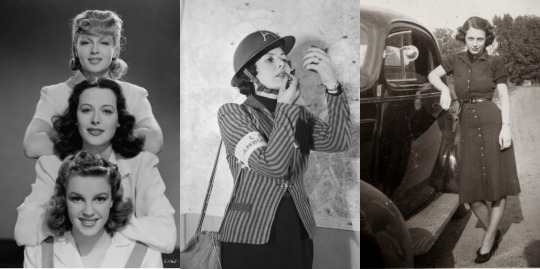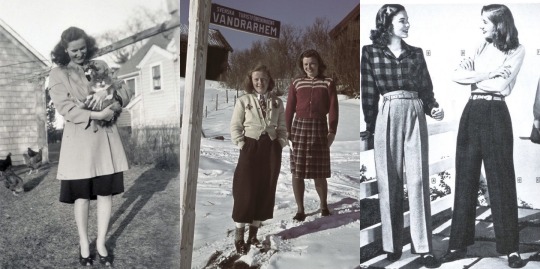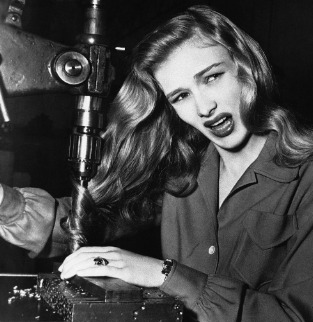#giggling and kicking my legs bc I get to talk about fashion history
Text
A quick introduction to 1940’s fashion
I've been so obsessed with Band of Brothers recently and I love reading the fanfics. Here’s my contribution, for your OC's.
(soon!) Part 2. Hair, makeup etc
(soon!) 1940's lookbook (photos)
The war had a major impact on 40's fashion. There were shortages and rations, and women were entering the workforce as men went off to war, leading to a more simplistic, utilitarian style.

Rations and regulations:
In the UK, clothing was rationed from June, 1941 to March, 1949, in varying strictness. So although you still payed for clothing with money, you'd need coupons to be allowed to buy them altogether. In the US, the Regulation L-85 (1942), rationed natural fibers and restricted how clothing could be made in order to save fabric. This meant regulating the skirt length, the fullness of pants and jackets, and even banned cuffs.
Silhouette:
The early 40's silhouette had strong, boxy shoulders, but by the mid forties and as the restrictions grew more strict, the silhouette softened to save materials. A nipped-in and high waistline stayed popular for the whole decade, and a hemline below the knee was fashionable until 1947, when Dior came out with the "New Look".

Fashion:
Because restrictions and shortages, the look was simple but stylish. Showy, over the top clothing was considered unfashionable to wear in wartime Britain.
The "military style" bled into every day fashion. It was common for men, who were not on active duty, to still wear bomber jackets, trench coats and aviator glasses. It's visible on women's fashion as well, which is why some of the clothing have a sort of a uniformly look.
Popular outfits for women were square-shouldered jackets with matching A-line skirts, shirtwaist dresses, and thanks to actresses, pants were now also a stable part of women's wardrobes. The pants had wide, straight legs and high waists, and were often paired with a colorful blouse or sweater and a matching jacket.
Hand knitting in Britain was at peak popularity during the war. Women on the home front were encouraged to "knit your bit" and contribute to the war effort by knitting for the troops. The warmth of woollen items also made knitwear popular for civilians.

Working women:
Women were entering the workforce to replace men, who went off to war. This required more practical attire, such as sturdy shoes, head scarves, overalls etc.
Some jobs (such as the WAVES) felt it important to emphasize that women wouldn't become any less feminine by working or wearing a uniform. This is why makeup, nail polish and feminine hairstyles weren't just largely allowed, they were encouraged.
Actress Veronica Lake, famous of her highly imitated "Peek-a-boo" hairstyle, where her hair covers one of her eyes, encouraged women working in factories to tie their hair up into safer styles to avoid injury. In this Safety Styles video, she has her hair up in a "victory roll" style.



The New Look by Dior:
After the long war, and as life was slowly returning back to normal, there was a want of "returning to femininity" among women. At the same time, some women feared that this ultra-femininity would set back all the progress they had made working outside the home during the war.
In 1947, Christian Dior released a new collection called ”The New Look” which featured a full, calf-length skirt. After the simple lines of the utility clothing, such a dress seemed desirable by contrast. The full skirt was also controversial for how much fabric it used, since rationing in the UK wouldn't end for another two years and there were still material shortages in both UK and the US.
Despite the controversies, the New Look was hugely popular and became the predominant silhouette well into the 1950's.

A/N: To keep this short, I had to paste and delete like half of what this originally was onto part 2. Also, lmk if there's interest in men's fashion ver. of this!
Hopefully this was legible. All the ”not my first language blah blah” stuff <3
sources: (links)
Imperial War Museum
National Museum of American History
centralcasting.com
V&A Museum (free 1940's knitting patterns!!)
NationalWW2museum.org
#giggling and kicking my legs bc I get to talk about fashion history#history#hbo war#fashion#fashion history#1940s fashion#1940s#oc inspiration
30 notes
·
View notes